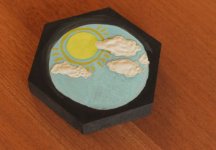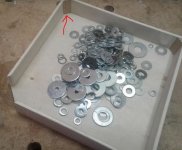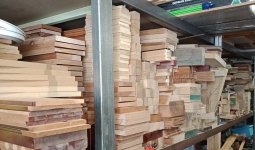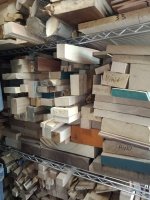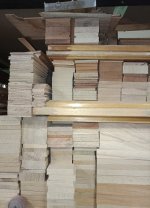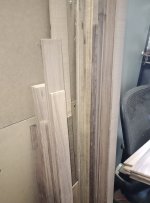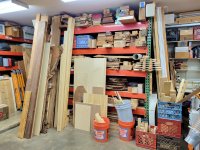Yesterday being the first day of Autumn, I decided it was a good day to start my Autumn shop cleaning.
My particular problem is that I have long rip off cuts. I work mostly in solid wood and built the doors, some windows, the hardwood flooring, and all the trim in my house. It's all the same species - Narra. I have some pieces that are over 15' long. Most are over 4' long. My problem is that in the past I have found uses for even narrow pieces - for instance as glass stops in the doors and windows, where a ½" x ½" piece that I cut with a chopped bevel is what my design calls for. And even pieces as short as 6", if they're wide enough, got used as baseboard plinth blocks. Pieces 5/8" x 2" were used for the top of my baseboards. I recently made a support leg for long boards on my workbench and built that from glued-up scrap. Cost me nothing in wood, but took more time than it should have. Heck, I once even made some chopsticks!
I'm lucky that my shop is my garage, which has a carport right next to it, and the carport's attic is open to the garage, so I'm able to store wood in the carport attic with the ends visible from the garage. But I had so many rip off-cuts that they just became a jangle mess. I do have a couple of wall-mounted racks for wood.
I'm trying to come up with a set of rules, but it's hard. For instance:
• Pieces shorter than 6" are kindling.
• Anything else that is 4" or wider is kept. I even have some ⅛" to ¼" thin pieces that I might use as veneers, but those need to be at least 3' long.
• Anything that's ¾" thick or thicker AND 2" wide or wider is kept.
• Otherwise, for boards under 8' long, the cross section needs to be a 1.25 square inches or more. So, a ⅝" thick board that's 3" wide is kept.
• For long boards (8' or longer), I'm keeping most that are ½" x ½" or more.
• I am keeping some pieces as narrow as ½" x ⅝" for use as replacement window stops. Some of my almost 30 year old insulated windows are starting to fog up and when I replace them it's actually easier to make new stops than to try to reuse the old stops, especially since even the outside are stain grade, not painted.
This may still end up with me keeping too many rip off-cuts. But, the thing I've learned over the decades is that keeping scrap you can't both see and get at easily is the worst thing you can do. Because if you can't easily find and get at the piece you need, you'll never get to them. Having a big box with off-cuts doesn't work since you're not going to go through the box (which typically means dumping the contents to sort and find and then put back in the back) to find a small piece. At least I've found that I'm not. So as I organize my scrap, it has to be placed such that I can see what they are (I'm labeling the ends for how long they are) and pull them out.
My situation may be unique in that I have primarily worked in one species (although that's starting to change as I build more furniture instead of just attached to house things). I do have some "special" boards that I've accumulated over the years (a 15" wide 12' long curly bubinga board, two 12" wide by 6' long book-matched Cuban mahogany boards from a tree that a hurricane knocked over, etc.), some exotics scraps, and about 150 bf of Cherry, another 125 bf of Canary wood, some curly maple and some bird's eye maple etc. that I'm keeping too, although I might decide to sell the Canary and bird's eye maple soon, but selling wood seems problematic. Thoughts there?

